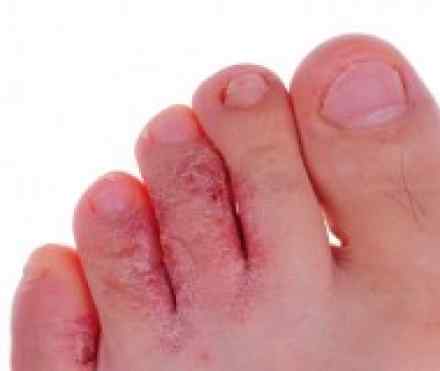
What is it?
Athlete's foot is a fungal infection that develops in the moist areas between your toes and sometimes on other parts of your foot. Athlete's foot usually causes itching, stinging and burning.
Also called tinea pedis, athlete's foot is closely related to other fungal infections with similar names, which include:
- Ringworm of the body (tinea corporis). This form causes a red, scaly ring or circle of rash on the top layer of your skin.
- Jock itch (tinea cruris). This form affects your genitals, inner upper thighs and buttocks.
- Ringworm of the scalp (tinea capitis). This form is most common in children and involves red, itchy patches on the scalp, leaving bald patches.
Symptoms
The signs and symptoms of athlete's foot can be numerous, although you probably won't have all of them:
- Itching, stinging and burning between your toes
- Itching, stinging and burning on the soles of your feet
- Itchy blisters
- Cracking and peeling skin, especially between your toes and on the soles of your feet
- Excessive dryness of the skin on the bottoms or sides of the feet
- Toenails that are thick, crumbly, ragged, discolored or pulling away from the nail bed
Causes
A group of mold-like fungi called dermatophytes causes athlete's foot. These organisms sprout tendril-like microscopic extensions that infect the superficial layer of the skin. In response to this fungal growth, the basal layer of the skin produces more skin cells than usual. As these cells push to the surface, the skin becomes thick and scaly. Most often, the more the fungi spread, the more scales your skin produces, causing the ring of advancing infection to form.
The organisms that cause athlete's foot thrive in damp, close environments created by thick, tight shoes that squeeze the toes together and create warm, moist areas between them. Damp socks and shoes and warm, humid conditions also favor the organisms' growth. Plastic shoes in particular provide a welcoming environment for fungal growth and infection.
Athlete's foot is contagious and can be spread in the following ways:
- Human to human. Athlete's foot often spreads by direct, skin-to-skin contact with an infected person. Not everyone who carries the fungus develops signs and symptoms of athlete's foot.
- Object to human. The fungus is carried on fragments of skin or other particles that contaminate floors, mats, rugs, bed linens, clothes, shoes and other surfaces. Although transmission can occur within a household, the infection is more commonly passed along in public areas — locker rooms, saunas, swimming pools, communal baths and showers.
- Animal to human. Household pets can pass along fungal infections to humans.
Risk factors
You are at higher risk of athlete's foot if you:
- Are a man
- Frequently wear damp socks or tightfitting shoes
- Share mats, rugs, bed linens, clothes or shoes with someone who has a fungal infection
- Frequently visit public areas where the infection can spread, such as locker rooms, saunas, swimming pools, communal baths and showers
- Have a weakened immune system
Diagnosis
Your doctor will want to determine if your signs and symptoms are caused by athlete's foot or by another skin disorder, such as dermatitis or psoriasis. You'll probably be asked about exposure to contaminated areas or contact with people who have athlete's foot.
Your doctor may take skin scrapings or fluid samples from your foot to view under a microscope to identify a fungus. If the sample shows a fungus, an antifungal medication is the usual treatment. If the test is negative but your doctor still suspects that you have athlete's foot, a sample may be sent to a laboratory to determine whether it will grow fungus under the right conditions. This test is known as a culture. Your doctor may also order a culture if your condition doesn't respond to treatment.
Treatments and drugs
If your athlete's foot is mild, your doctor may suggest using an over-the-counter antifungal ointment, lotion, powder or spray. If your athlete's foot doesn't respond, you may need a prescription-strength topical medication or an oral (systemic) medication.
Over-the-counter medications
There are numerous over-the-counter (OTC) medications on the market. Medicated powders also will help keep your feet dry. OTC medications include:
- Butenafine
- Clotrimazole
- Miconazole
- Terbinafine
- Tolnaftate
Prescription medications
If athlete's foot is severe or doesn't respond to over-the-counter medicine, you may need a prescription-strength topical or oral medication.
- Topical medications. These include clotrimazole and miconazole.
- Oral medications. These include itraconazole (Sporanox), fluconazole (Diflucan) and terbinafine (Lamisil). Side effects from oral medications include gastrointestinal upset, rash and abnormal liver function. Taking other medications, such as antacid therapies for ulcer disease or gastroesophageal reflux disease (GERD), may interfere with the absorption of these drugs. Oral medications for athlete's foot may alter the effectiveness of warfarin, an anticoagulant drug that decreases the clotting ability of your blood.
Your doctor may prescribe an oral antibiotic if you have an accompanying bacterial infection. In addition, your doctor may recommend wet dressings, steroid ointments, compresses or vinegar soaks to help clear up blisters or soggy skin.
Wash and dry the affected area. Then, apply a thin layer of the topical agent once or twice a day for at least two weeks, or according to package directions. If you don't see an improvement after four weeks, see your doctor.
If your athlete's foot recurs frequently, your doctor may recommend that you use a medication continuously.
Prevention
These tips can help you avoid athlete's foot or ease the symptoms if infection occurs:
- Keep your feet dry, especially between your toes. Go barefoot to let your feet air out as much as possible when you're home.
- Go with natural materials. Wear socks that are made of natural material, such as cotton or wool, or a synthetic fiber designed to draw moisture away from your feet.
- Change socks and stockings regularly. If your feet sweat a lot, change your socks twice a day.Wear light, well-ventilated shoes. Avoid shoes made of synthetic material, such as vinyl or rubber.
- Alternate pairs of shoes. Don't wear the same pair every day so that you give your shoes time to dry between wearings.
- Protect your feet in public places. Wear waterproof sandals or shower shoes in communal showers, pools, fitness centers and other public areas.
- Treat your feet. Use powder, preferably antifungal, on your feet daily.
- Don't share shoes. Sharing risks spreading a fungal infection.
References:
http://www.hse.ie/eng/health/az/A/Athlete's-foot/Treating-athlete's-foot.html
http://www.medicinenet.com/athletes_foot/article.htm
https://en.wikipedia.org/wiki/Athlete%27s_foot
http://www.quickanddirtytips.com/health-fitness/mens-health/how-to-treat-athletes-foot
http://www.irishhealth.com/article.html?con=273



